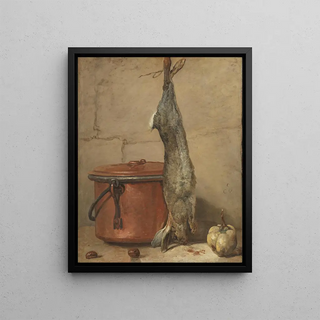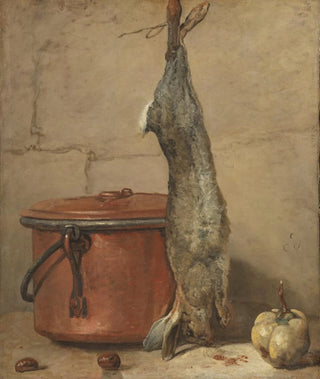Art print | Rabbit and copper pot - Jean Siméon Chardin


View from behind

Frame (optional)
Reproduction of Lapin et marmite en cuivre by Jean Siméon Chardin – Captivating Introduction
In the rich and intricate universe of 18th-century French painting, the artwork Lapin et marmite en cuivre by Jean Siméon Chardin stands out for its depth and apparent simplicity. This canvas, capturing a moment of everyday life, evokes an atmosphere of calm and contemplation. The depiction of a rabbit, both delicate and raw, paired with a copper pot, invites the viewer to delve into the realities of the customs of the time, while revealing the artist's technical mastery. Chardin, often regarded as the master of still life, manages to transcend mere representation to offer a reflection on the very nature of life and death.
Style and uniqueness of the work
Chardin's style is characterized by meticulous attention to detail and a color palette that evokes softness and warmth. In Lapin et marmite en cuivre, light plays a fundamental role, illuminating the shiny surfaces of the copper and creating delicate shadows that bring the composition to life. Textures are rendered with remarkable precision, allowing the viewer to almost feel the softness of the rabbit's fur and the coldness of the metal. This painting is not just a tribute to still life but a psychological study of objects and their significance. Chardin manages to infuse a soul into his inanimate subjects, transforming a simple meal into a meditation on mortality and the passage of time.
The artist and his influence
Jean Siméon Chardin, born in 1699, is often considered one of the pioneers of the still life genre in France. His career, marked by an unceasing quest for truth and authenticity, profoundly influenced subsequent generations of artists. Chardin was able to distance himself from the conventions of his time, preferring to depict scenes of daily life rather than the historical or mythological subjects favored by his contemporaries. His innovative approach paved the way for a new perspective on painting, where simplicity and the beauty of everyday objects are celebrated. His work inspired artists such as Édouard Manet and Pablo Picasso, who saw in him a model of authenticity.

Matte finish

View from behind

Frame (optional)
Reproduction of Lapin et marmite en cuivre by Jean Siméon Chardin – Captivating Introduction
In the rich and intricate universe of 18th-century French painting, the artwork Lapin et marmite en cuivre by Jean Siméon Chardin stands out for its depth and apparent simplicity. This canvas, capturing a moment of everyday life, evokes an atmosphere of calm and contemplation. The depiction of a rabbit, both delicate and raw, paired with a copper pot, invites the viewer to delve into the realities of the customs of the time, while revealing the artist's technical mastery. Chardin, often regarded as the master of still life, manages to transcend mere representation to offer a reflection on the very nature of life and death.
Style and uniqueness of the work
Chardin's style is characterized by meticulous attention to detail and a color palette that evokes softness and warmth. In Lapin et marmite en cuivre, light plays a fundamental role, illuminating the shiny surfaces of the copper and creating delicate shadows that bring the composition to life. Textures are rendered with remarkable precision, allowing the viewer to almost feel the softness of the rabbit's fur and the coldness of the metal. This painting is not just a tribute to still life but a psychological study of objects and their significance. Chardin manages to infuse a soul into his inanimate subjects, transforming a simple meal into a meditation on mortality and the passage of time.
The artist and his influence
Jean Siméon Chardin, born in 1699, is often considered one of the pioneers of the still life genre in France. His career, marked by an unceasing quest for truth and authenticity, profoundly influenced subsequent generations of artists. Chardin was able to distance himself from the conventions of his time, preferring to depict scenes of daily life rather than the historical or mythological subjects favored by his contemporaries. His innovative approach paved the way for a new perspective on painting, where simplicity and the beauty of everyday objects are celebrated. His work inspired artists such as Édouard Manet and Pablo Picasso, who saw in him a model of authenticity.






